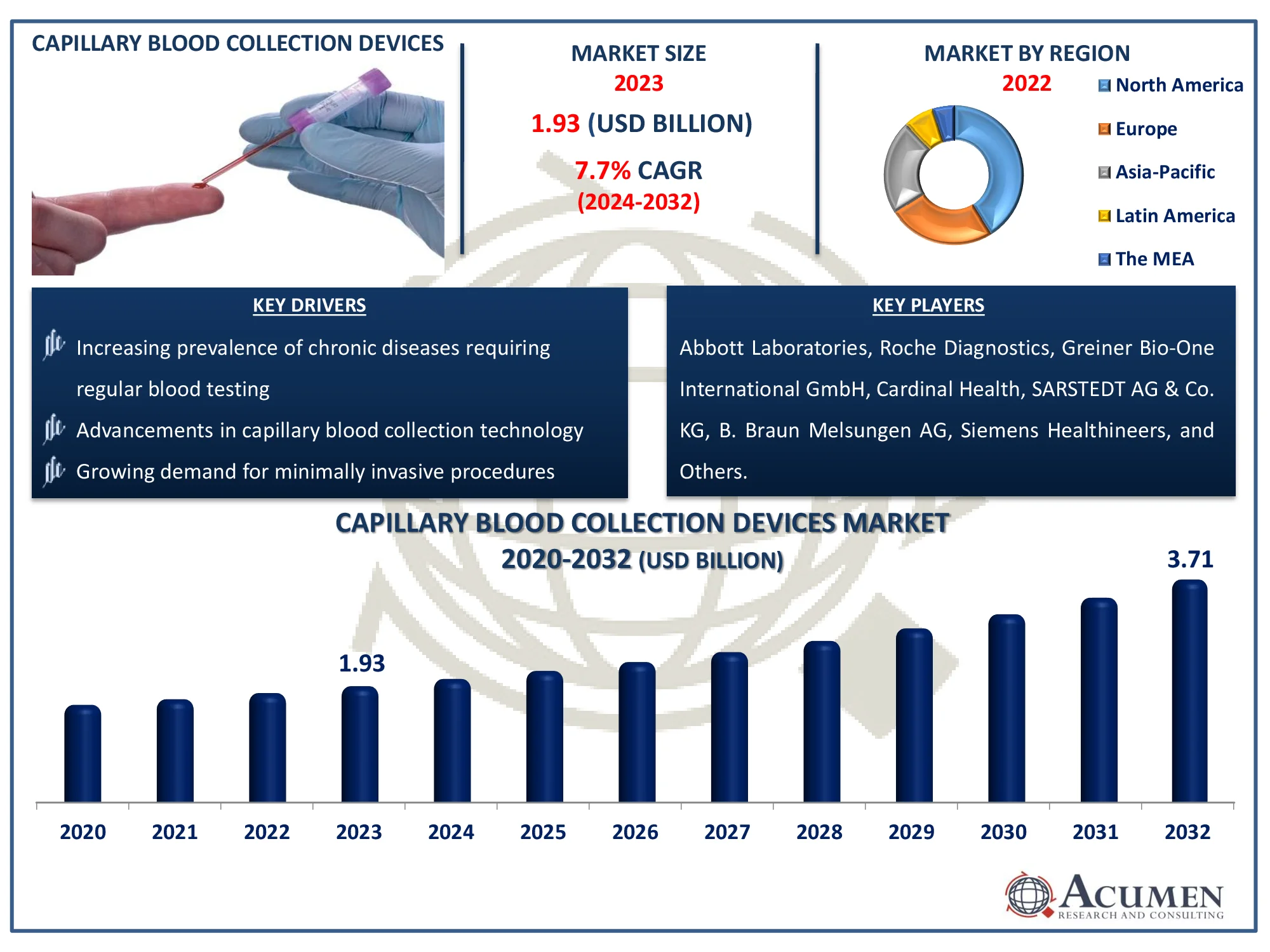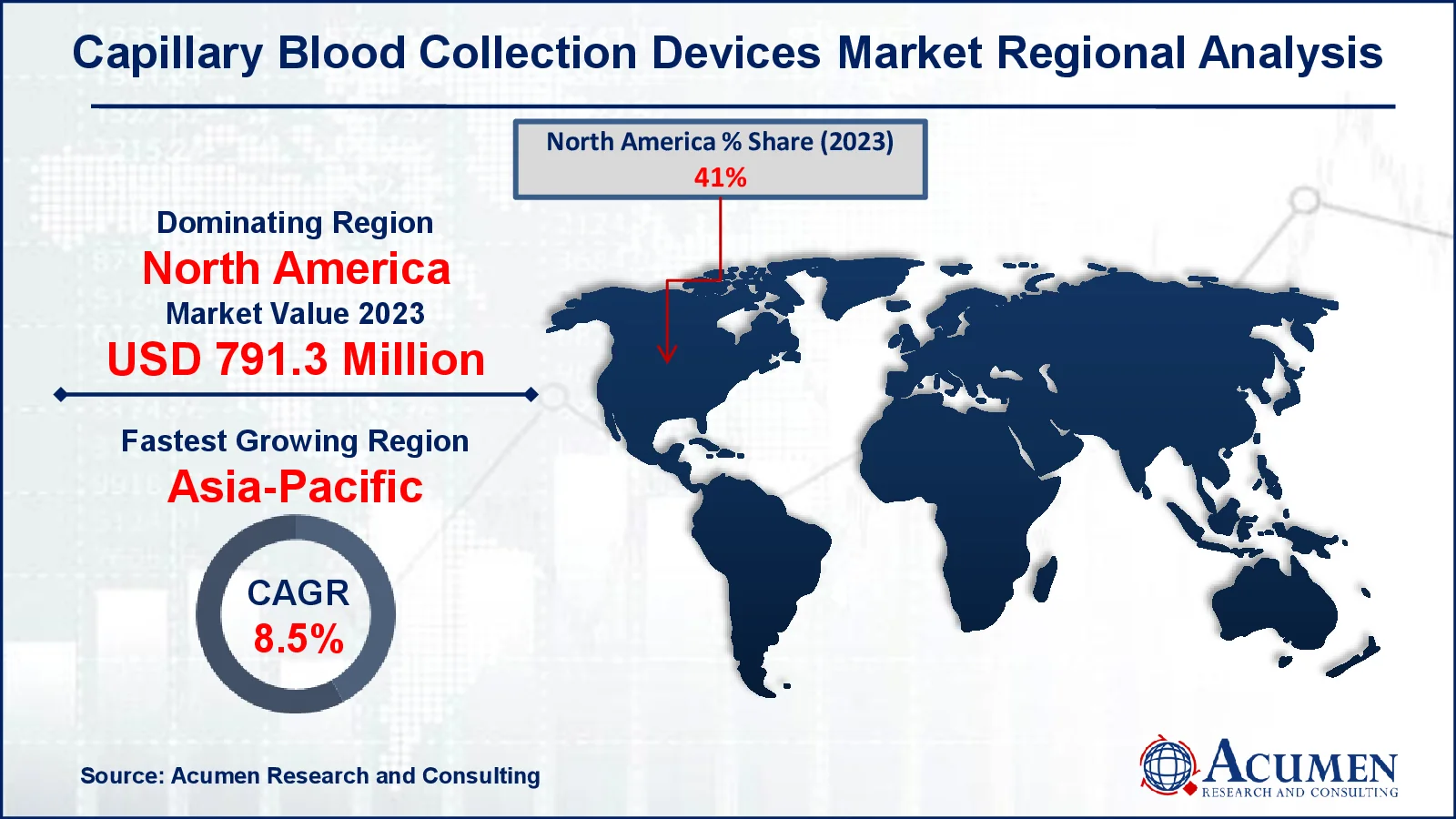November 2020
The Capillary Blood Collection Devices Market is set to grow from USD 1.93 Billion in 2023 to USD 3.71 Billion by 2032, at a CAGR of 7.7%. Explore key trends and market dynamics in our detailed analysis.
The Capillary Blood Collection Devices Market Size accounted for USD 1.93 Billion in 2023 and is estimated to achieve a market size of USD 3.71 Billion by 2032 growing at a CAGR of 7.7% from 2024 to 2032.
Capillary Blood Collection Devices Market Highlights

Capillary blood collection devices are tools used to obtain blood samples through a simple and minimally invasive method. These devices typically include lancets or needles designed for shallow punctures of the skin, usually the fingertip. Once the skin is punctured, capillary action draws a small amount of blood into the device for collection. This method is commonly used in settings where venous blood collection may be challenging or unnecessary, such as for glucose was monitoring in diabetes management, point-of-care is testing, and pediatric blood sampling. Capillary blood collection devices are convenient for rapid tests and are designed to minimize discomfort and risk for the patient while providing sufficient blood volume for diagnostic purposes.
Global Capillary Blood Collection Devices Market Dynamics
Market Drivers
Market Restraints
Market Opportunities
Capillary Blood Collection Devices Market Report Coverage
| Market | Capillary Blood Collection Devices Market |
| Capillary Blood Collection Devices Market Size 2022 |
USD 1.93 Billion |
| Capillary Blood Collection Devices Market Forecast 2032 | USD 3.71 Billion |
| Capillary Blood Collection Devices Market CAGR During 2023 - 2032 | 7.7% |
| Capillary Blood Collection Devices Market Analysis Period | 2020 - 2032 |
| Capillary Blood Collection Devices Market Base Year |
2022 |
| Capillary Blood Collection Devices Market Forecast Data | 2023 - 2032 |
| Segments Covered | By Type, By Product, By Application, By End-Use, And By Geography |
| Regional Scope | North America, Europe, Asia Pacific, Latin America, and Middle East & Africa |
| Key Companies Profiled | Abbott Laboratories, Roche Diagnostics, Greiner Bio-One International GmbH, Cardinal Health, SARSTEDT AG & Co. KG, B. Braun Melsungen AG, Siemens Healthineers, Guangzhou Improve Medical Instruments Co. Ltd., Radiometer Medical, Terumo Medical Corp, and Becton, Dickinson and Company (BD). |
| Report Coverage |
Market Trends, Drivers, Restraints, Competitive Analysis, Player Profiling, Covid-19 Analysis, Regulation Analysis |
Capillary Blood Collection Devices Market Insights
The rising prevalence of chronic diseases necessitates frequent blood testing, fueling demand for capillary blood collection devices. For instance, according to Center of Disease Control And Prevention, over the last twenty years, the prevalence of chronic conditions has steadily risen, and this trend is anticipated to persist. An increasing number of Americans are managing multiple chronic conditions: 42% have at least two, and 12% have five or more. These minimally invasive tools are essential for accurate and convenient blood sample collection, especially for patients requiring regular monitoring. As healthcare systems emphasize early diagnosis and continuous management, the market for these devices is expanding.
High costs associated with advanced capillary blood collection devices can act as a significant restraint for the market. These devices often require sophisticated technology and materials, leading to higher production costs. As a result, the increased prices can limit accessibility, particularly in cost-sensitive regions and among smaller healthcare providers. Consequently, the adoption of these advanced devices may be slower, impacting market growth.
The integration of digital health solutions for remote monitoring and diagnostics significantly enhances the capillary blood collection devices market. For instance, according to World Health Organization, it's important to understand that digital health involves much more than just electronic medical records. It is fundamental to the success of any healthcare system. Moreover, these solutions enable real-time data transmission and analysis, facilitating timely and accurate health assessments. This convenience and efficiency drive the demand for user-friendly, minimally invasive capillary blood collection devices. Consequently, the market for these devices expands as they become essential tools in modern telehealth and remote patient care systems.
Capillary Blood Collection Devices Market Segmentation
The worldwide market for capillary blood collection devices is split based on material, product, application, end-use, and geography.
Capillary Blood Collection Device Market By Material
According to the capillary blood collection devices industry analysis, the plastic segment dominates due to its superior properties such as lightweight, durability, and cost-effectiveness. Plastic materials offer excellent biocompatibility and versatility in design, making them ideal for single-use devices, reducing contamination risks. Additionally, the ease of mass production and customization of plastic devices further enhances their market dominance. The widespread use in various healthcare settings solidifies plastic's leading position in this segment.
Capillary Blood Collection Device Market By Product
According to the capillary blood collection devices industry analysis, lancets are pivotal in the market, offering a critical role in healthcare diagnostics. Their dominance stems from their efficiency in obtaining blood samples for glucose monitoring and other diagnostic tests. With advancements in technology, lancets have evolved to be safer, more precise, and less painful for patients, contributing significantly to the market's growth. Their widespread adoption across healthcare settings underscores their indispensable role in modern medical practices.
Capillary Blood Collection Device Market By Application
Capillary blood collection devices are crucial in healthcare settings for obtaining blood samples, especially in applications dominated by whole blood tests. These devices facilitate minimally invasive sampling, making them ideal for point-of-care testing and home healthcare. The dominance of whole blood tests underscores the devices' utility in diagnostics, offering rapid results for glucose monitoring, lipid profiling, and hemoglobin testing. Their portability and ease of use make capillary blood collection devices indispensable tools in modern healthcare, enhancing patient convenience and diagnostic efficiency.
Capillary Blood Collection Device Market By End-Use
According to the capillary blood collection devices industry analysis, their dominance in these settings is due to their efficiency in obtaining blood samples with minimal invasiveness, making them ideal for patients of all ages, including infants and elderly individuals. These devices enable healthcare professionals to perform quick tests at the point of care, enhancing diagnostic speed and accuracy. As a result, hospitals and clinics constitute the primary end-users driving the market growth for capillary blood collection devices globally.
Capillary Blood Collection Devices Market Regional Outlook
North America
Europe
Asia-Pacific
Latin America
The Middle East & Africa

Capillary Blood Collection Devices Market Regional Analysis
For several reasons, in North America, the capillary blood collection devices market is predominantly led by advancements in healthcare infrastructure and diagnostic technologies. The region benefits from extensive healthcare expenditure and a robust regulatory framework that supports innovation. Additionally, strong partnerships between healthcare providers and manufacturers contribute to a competitive landscape marked by rapid adoption of new devices and technologies. For instance, In December 2023, Becton, Dickinson and Company announced FDA 510(k) clearances for the BD MiniDraw Collection System, a new device designed for low-volume blood collection via fingersticks. This system enables testing for lipid panels, selected chemistry tests, and hemoglobin/hematocrit (H&H) with lab-quality results, thereby expanding the company's range of blood testing capabilities. Moreover, high prevalence of chronic diseases and growing emphasis on point-of-care testing further drive market growth.
Asia-Pacific is fastest-growing region in capillary blood collection devices market and it’s projected to grow significantly over the forecast period, driven by a dense population and rising incidences of chronic diseases like diabetes and cancer in the region. For instance, according to National Institute of Health, China shows a higher incidence of cardiovascular disease (CVD), cancer, chronic respiratory disease (CRD), and diabetes compared to countries and regions at similar levels of social development. This higher prevalence led to drive demand for capillary blood collection devices market as it require regular blood testing.
Capillary Blood Collection Devices Market Players
Some of the top capillary blood collection devices companies offered in our report includes Abbott Laboratories, Roche Diagnostics, Greiner Bio-One International GmbH, Cardinal Health, SARSTEDT AG & Co. KG, B. Braun Melsungen AG, Siemens Healthineers, Guangzhou Improve Medical Instruments Co. Ltd., Radiometer Medical, Terumo Medical Corp and Becton, Dickinson and Company (BD).
Looking for discounts, bulk pricing, or custom solutions? Contact us today at sales@acumenresearchandconsulting.com
November 2020
December 2020
October 2022
April 2020